Where to go in Switzerland on a short trip: Alps, lakes, and cities
Switzerland is an extremely popular country for those planning multi-stop tours around Europe, yet very few potential first-time visitors actually know specifically where they want to go. Everyone seems to know that it has the most beautiful views of the Alps and some very impressive cities, but there are actually many misconceptions among casual trip planners, so I’d like to clear most of that up below. The places to visit in Switzerland are not obvious until you’ve been there yourself or done many hours of research, so the list below should be a short cut.
I get hundreds if not thousands of itinerary questions for people who are considering a Eurail trip around Europe, and most people just include the word “Switzerland” among a list of cities like Paris, Rome, and Berlin that they want to visit. So where in Switzerland should you go if you can only make a few stops at most? I’ll answer that question below. You’ll mostly want to focus on the best choices for Swiss Alps trips, which I’ll go over below.
Note: This article was expanded and updated in February, 2024.
Switzerland is about outdoor views rather than city visits
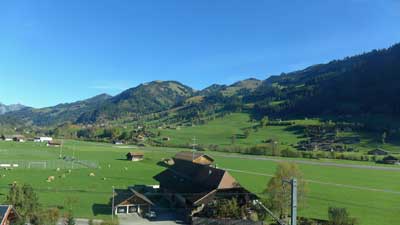
Geneva is a very famous city (though not for tourism reasons) on a lovely lake of the same name, but it’s also notoriously dull and lacking distinction. Rick Steves puts it well by saying that “Geneva is pleasantly situated on a lake, like Buffalo or Cleveland.” The point is, you don’t want to go to Geneva unless you’ve got something specific in mind that you want to see there. There are much better places to visit in Switzerland if your time is limited, or even if it’s not.
Switzerland's cities in summary
Zurich – The largest city, very expensive, geared towards business travelers. It’s generally a pretty and very well-run city that you would enjoy if you visited, but it’s not nearly as interesting as the likes of Vienna, Munich, or of course Paris.
Geneva – Second largest city, in the French part of the country, no major sights. Again, if you visited you’d be very impressed by it and get some great photos, but it’s not worth your time unless you know someone there. There’s an impressive fountain in the lake and you can usually see it from the train as you go through the city, but it’s not really worth going there and staying more than an hour or so.
Basel – Bordering France and Germany, no major sights. It has the famous art market each year, and aside from that it’s even duller than the ones above. Again, if you visited you’d be impressed, but if you later compared photos with friends who went to the Lauterbrunnen Valley instead, you’d kick yourself for going to Basel.
Lausanne – Near Geneva in the French part of the country, very hilly, and certainly more interesting than Geneva.
Bern – The capital, compact, on a lovely river, some interesting sights and the best Swiss city to get a feel for the culture. Bern is fairly close to Interlaken (which we will discuss below) and it can be a great day trip from there, especially on a day where it is foggy and/or rainy in the mountains (and this happens a LOT).
How much time and which Swiss cities to visit?
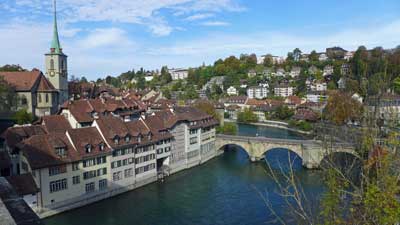
Many people (me included) don’t feel as if they’ve scratched the surface of a new country if they haven’t spent at least a day or two in the largest city. Zurich is certainly pleasant and a useful transit hub so spending one or two nights there wouldn’t be a major mistake. But Zurich isn’t even close to being a city like Paris, Rome, Berlin, Amsterdam, or even Vienna. If you skip it in favor of spending more time in the Swiss Alps, you won’t be missing much.
The 2 Best places to visit in Switzerland for short visits
Interlaken – If you want the best possible Alpine views and activities, head to the Interlaken area, which will be described in detail below. This is my favorite of all places to visit in Switzerland and it will probably be yours as well.
Lucerne – The traditional Swiss tourist retreat, Lucerne is a small city with interesting culture and sights, that is gorgeously set on a lake with plenty of top activities surrounding it.
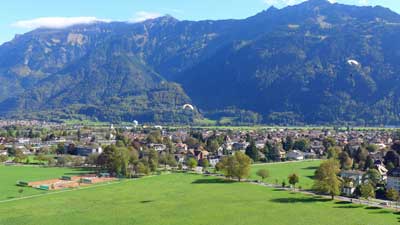
>>>Interlaken and Lucerne: Which to choose and how long to stay in each?
The article linked above will give you more details on which to choose and how long to spend in each place.
What about Zermatt for Alpine views?
Zermatt is a remote car-free village in southern Switzerland that is famous for being the place to see the Matterhorn mountain. It’s also a busy ski resort area, and aside from that, there isn’t much to see or do here. It’s on a private rail line, so it’s more complicated and usually more expensive to reach than Interlaken.
In other words, unless you’ve irrationally placed “Seeing the Matterhorn in person” on your so-called bucket list, skip Zermatt and head to Interlaken on a shorter visit. You won’t be sorry. If you already have enough time in your visit for the main sights around Interlaken and Lucerne and you want to also see the Matterhorn, then by all means go and you’ll enjoy it. There are quite a few other car-free villages in the Lauterbrunnen Valley near Interlaken, so they are not as novel in Switzerland as one might expect.
A weekend in Switzerland? What to see in 3 days
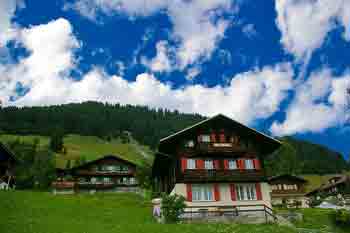
One challenge is that neither has an international airport so you’ll either be flying into Zurich or perhaps Geneva.
Train times from Zurich to Lucerne to Interlaken and back
- Zurich Airport to Lucerne: 1 hour 10 minutes by train
- Lucerne to Interlaken: 2 hours by train
- Interlaken to Zurich Airport: 2 hours 15 minutes by train
As you can see with the travel times above, Zurich Airport to Lucerne is a fairly short trip, but once you add Interlaken into the mix (even if you skip Lucerne) the travel time starts to add up for a weekend visit. With this in mind it’s probably best to just choose one of them and save the other one for another trip.
Lucerne is gorgeous, but the Lauterbrunnen Valley near Interlaken is really the star of the show, so I’d recommend going there first and doing Lucerne on another trip.
What about the Swiss Travel Pass?

The bottom line is that if you are coming to Switzerland for at least 3 days and you want to take 2 or more of the amazing scenic rail journeys that the country is famous for, the travel pass is probably a good deal. It also provides 50% discounts on the Schilthorn cable car and 25% off the Jungfraujoch mountain railway. Both of those are quite expensive on their own, but extremely worthwhile, so the discount is helpful.
The Half Fare Card is probably a better deal for most people
The Swiss Travel Pass is a good deal for those who are going to be spending at least 2 or 3 days riding the rails and seeing Switzerland that way. But if you are mostly going to be focusing on Interlaken and Lucerne and the mountain sights, the Half Fare Card is the best option. For CHF120 (about US$134) you get the card that is good for 30 days and gives you a 50% discount on all trains, cable cars, mountain railways, and other sights and attractions. If you are doing either Schilthorn or Jungfraujoch, the Half Fare Card practically pays for itself with just one of those.
>>>Buy the Swiss Half Fare Card
Many people have questions about the Swiss Half Fare Card so I will explain it a bit here. You can actually buy half price train tickets for travel within Switzerland any time you want and you will see that option when you go to buy them online. The only thing is you have to have and present a valid Half Fare Card when you get on the train and are asked to see your ticket. In other words, you can buy a half fare train ticket today and buy a Half Fare Card just before you get on that train months in the future, and you are fine.
How and why visit the area around Interlaken
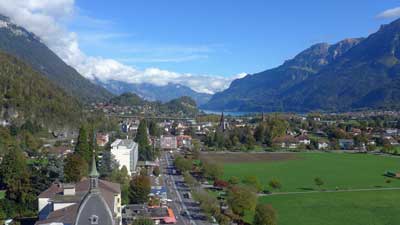
You can see everything discussed below by actually staying in a hotel in Interlaken, but it’s not the Alpine experience that you get if you stay in one of the small villages nearby. You can reach those villages in 20 to 40 minutes from the Interlaken Ost (East) train station, and it’s much easier than it sounds.
The 3 best places to stay to visit the Swiss Alps
Lauterbrunnen – A private train line runs from Interlaken Ost station to the end of its line in Lauterbrunnen. There’s a lovely waterfall here and great hiking trails, but you should probably only stay here if you can’t get to one of the villages mentioned just below. It’s a great little transit hub and it’s definitely gorgeous, so it can be worth a night if you’ve got one to spare.
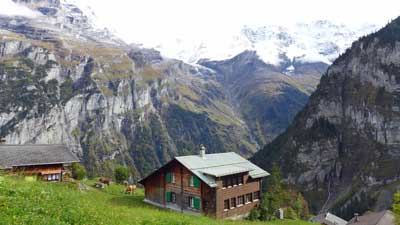
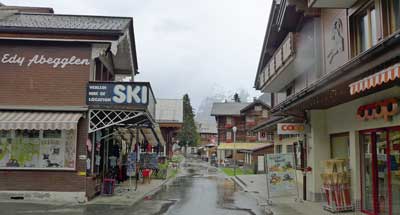
Where to stay in Interlaken and the Lauterbrunnen Valley (with pics)
I get so many questions about where to stay in the Interlaken area that I decided to write a longer version of it and load it with huge photos so readers can get a better feel for each option. I also included recommendations for affordable and well-located photos in each area.
>>>Where to stay in Interlaken and the Lauterbrunnen Valley New for 2024!
The unforgettable things to see here (if the weather is decent)
Schilthorn observation deck and restaurant
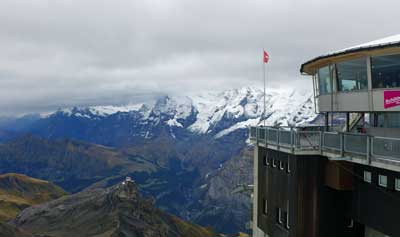
There is a rotating restaurant (with prices similar to normal Swiss restaurants) and a bizarre and anachronistic James Bond attraction based on it being a key location in the 1969 movie On Her Majesty’s Secret Service. The Bond thing is included with the lift, and it’s worth a look.
But the main thing you come here for is the 360-degree view from one of the highest peaks in Europe. Again, the weather here is key, but fortunately all the locals track the visibility on a minute-by-minute basis. If it’s clear up top while you are in the area, it would be a terrible shame to skip it based on the high price. But even if it’s cloudy up top, there are still plenty of wonderful things to see and do in the villages below.
Jungfraujoch observation area
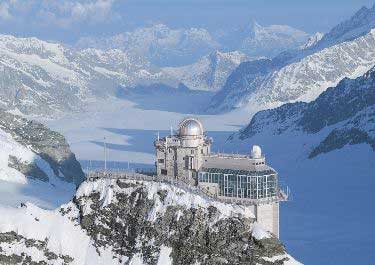
The views from the top are similar to the views from Schilthorn, from the other side of the Lauterbrunnen Valley. Once on top you can have lunch, hike, or even go sledding. It’s also quite expensive at nearly US$200 round-trip unless you have a Swiss Pass or a Eurail Pass for discounts, and it takes most of your day, but you’ll never forget the views from the top.
Harder Kulm mountain and Two Lakes Bridge Observation Deck
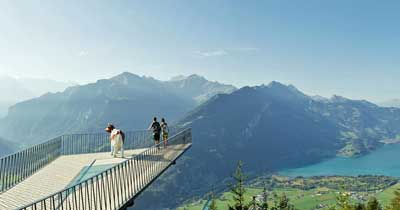
There’s a revolving restaurant about 10 minutes’ walk from the station at the top, which is definitely an unforgettable place for lunch if you’ve got time. It’s not as expensive as you might expect, at least compared to normal restaurants in Switzerland.
The Harder Kulm Railway goes from early April through late November each year. If you are only in Interlaken for one day and/or you are on a strict budget, this is the fastest and best way to get amazing Alpine views in the area.
Getting from Interlaken to Gimmelwald and Mürren
Getting up to these villages sounds complicated and time consuming, but it’s actually fast and easy once you get there. This little guide should help.
Arrive in Interlaken
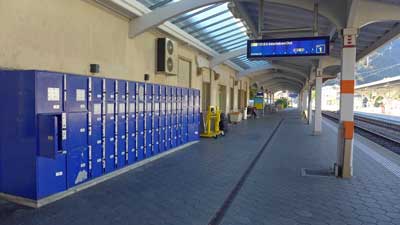
Once you arrive at the Interlaken Ost train station, head for the ticket windows in the office and buy a ticket to your final destination (Lauterbrunnen, Gimmelwald, or Mürren). Eurail passes are good for 25% discounts on the rest of the trip, but not for the whole thing.
From Interlaken Ost to Lauterbrunnen
The private train leaves Interlaken Ost every 30 minutes and arrives in Lauterbrunnen 20 minutes later. If you are staying in Lauterbrunnen then you are probably walking distance from your hotel when you reach the station.
From Lauterbrunnen to Gimmelwald
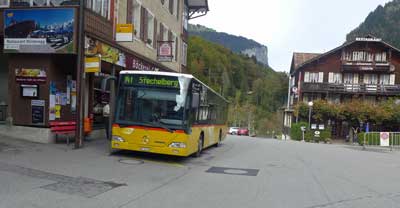

From
Gimmelwald to Mürren
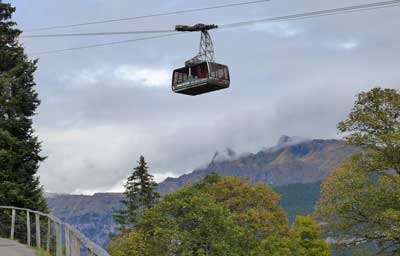
Recommended hotel and hostel in Gimmelwald
I get asked all the time about where to stay in Gimmelwald, so here it is:
Hotel: Esther’s Guesthouse
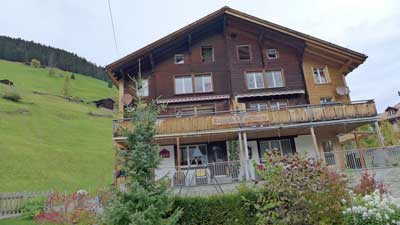
It’s run by Esther, as you might guess, and she is very friendly speaking excellent English. Each room is different and the place feels like a mountain cabin, because it is. She offers an excellent buffet breakfast in the morning, which you have to order the night before. It’s not cheap, but it’s worth it because it’s hearty and there are no other good options nearby.
Book as early as possible because this place is often the first place to sell out in Gimmelwald.
Hostel: Mountain Hostel Gimmelwald
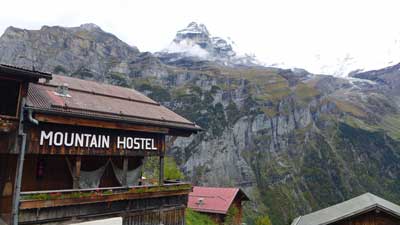
You won’t believe the views from this place, which are the same as from Esther’s except a bit lower and more unobstructed. This place also has a busy bar and restaurant that is basically the only “nightlife” in Gimmelwald. Many hikers get to bed early in this tiny village, but if you want to have a couple drinks and order a pizza or some local options, this is the place to go.
Again, book early because this place is always sold out.
Lucerne and what to do there
Luzern, as it’s spelled locally, is the other traditional holiday destination in Switzerland. Unlike Interlaken, Lucerne actually qualifies as a small city rather than a small resort town, so it’s a very nice contrast and very worthwhile. We have a new article with advice on where to stay in Lucerne and it should be helpful.
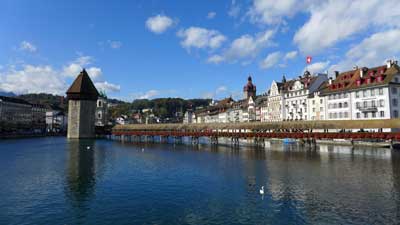
However, unlike Interlaken, the town of Lucerne itself is a great attraction and worth at least a day of exploration. This has always been a rich area so you can expect to find all of the high-end shops and boutiques along the small streets just north of the lake, but there are also many traditional shops and things to see that will appeal to anyone.
Recommended hotel in Lucerne
>>Hotel Des Alpes (3 stars with an amazing location and view)

If this place is booked, which is often the case, then book a hotel as close to it as you can find or afford. The whole historic part of town surrounding it is lovely, with restaurants, bars, and high-end shops. There are also a couple of nearby supermarkets where you can buy inexpensive alcohol and picnic supplies to keep other costs down.
Spend a day in Lucerne itself
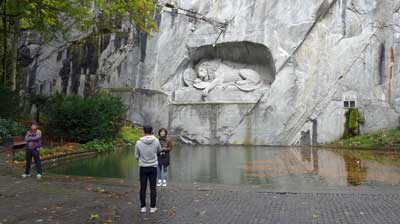
Most of the interesting part of Lucerne is in the area behind those restaurants, and it’s certainly worth doing a self-guided walking tour if not a guided one. Heading farther east you’ll come to another older part of town where the famous lion statue is located. You can’t visit Lucerne without having a look at the lion, and fortunately it’s easy and quick to reach (and it’s free).
Take a lake cruise of some kind
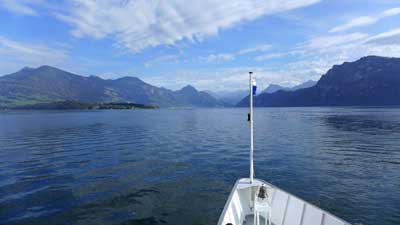
Especially in nice weather, even the short lake tour is lovely, and if you have more time you can jump off at Vitznau and do the scenic hike up Mount Rigi. There are also small lakeside villages that are ideal for a stroll and lunch stop. Long story short, there are dozens of interesting sightseeing options that are available using part of the boat tour, and the views all around are wonderful.
Visit Mount Pilatus
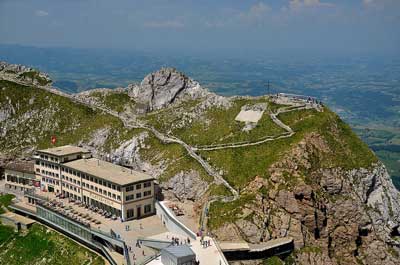
You can take the cogwheel train up and have a more or less flat hike around the summit area, and then take the gondola and cable car back down again. You can do them in the other order, and the cost is the same either way. At around US$65, this is not a cheap hike, but like most everything in Switzerland, the quality is high so it doesn’t feel like a rip-off. You can reach the cable car in 10 minutes on a public trolly bus from Lucerne.
Visit Mount Rigi
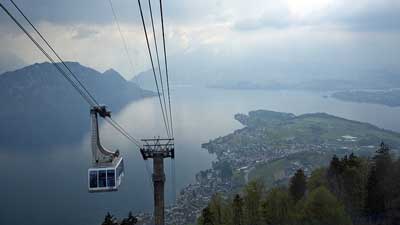
Unlike the other peaks mentioned in this article the Swiss Travel Pass covers both ways to get up and down for free. The others are 50% off with the Swiss Travel Pass or Half Fare Card, except for Jungfraujoch, which is only 25% off with the Swiss Travel Pass and still 50% off with the Half Fare Card.
Visit Mount Titlis
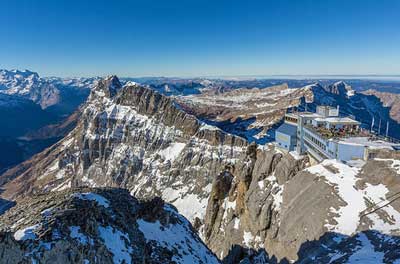
You can reach Titlis by taking a 43-minute train ride from Lucerne to Engelburg and then taking the cable car up from there. As with the others, it’s wise to check the weather immediately before you are going to depart because it can be foggy or cloudy any time of the year, but usually not for whole days at a time.
Additional photo credits
Jungfraujoch by cupweuro on Flickr, Pilatus by Tony Fernandez on Flickr, Rigi by Kosala Bandara on Flickr, Titlis by PaulSchliebs on Flickr

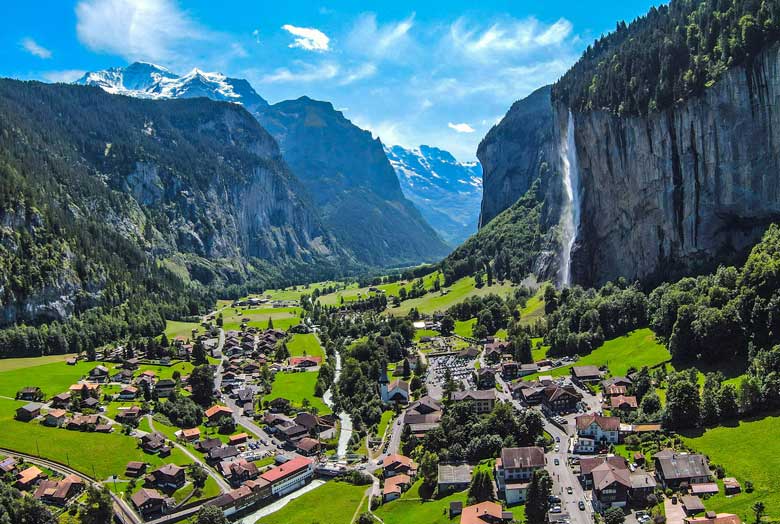
we are planning for Switzerland trip from n December 24th to Jan 3rd.
We have planned to visit from Geneva to Zurich or vice versa by rental. cars. Kindly assist me which all the places are best to visit and places to stay near by.
Jisha,
The entire article above is meant to answer that exact question you asked. I really don’t recommend spending any time in Geneva, and not more than a day in Zurich. You really want to spend time in Interlaken and Lucerne, and perhaps another of the places mentioned in the article. I’m happy to answer questions for people who are unsure of some details, but I can’t write up an itinerary from scratch. -Roger
Hi Roger
Your article has helped me a lot in preparing for my trip. However I am still in doubt whether I need the Swiss pass. I would be staying in Bern and will be spending a day each in Interlaken and Lucerne. I do plan to visit Schilthorn but not planning on train rides though.
Will it still be reasonable travelling on trains without the Swiss Pass?
Regards
Prabhjot
Prabhjot,
As I mention in the Swiss Travel Pass review, it’s quite expensive so it’s only really good value for those who are planning on doing at least two of the more expensive scenic trains, and also one or more of the other included mountain adventures. From the sound of it, you’ll save money by just paying as you go. The train rides within Switzerland aren’t too expensive, partly because the distances aren’t very long. And the fares are the same no matter when you buy, although in some cases they do offer a Supersaver fare that is even lower. The cable car up to Schilthorn is expensive, but as long as the weather is mostly clear up top (and it’s easy to find out before you go), the views are stunning and well worth it.
So if you know when you want to go on the trains, check the sbb.com website to see if there is a supersaver fare. If there is, buy it then for the best price, but if not you can just buy tickets as you go from the stations. The clerks in the main stations all speak English well and it’s easy, since they are such a major tourist destination. Have a great trip. -Roger
Hi Roger,
Thanks for sharing valuable information about Switzerland.
i’m planning to stay 4 days in Paris and 7 days in Switzerland in the end of september.
1) In Switzerland i planned to stay 3 days in Murren, 2days in Lucerne and 2 days in bern. In Murren i like to experience two famous scenic rides.
2) I need to know is there any scenic train routes from Paris to Interlaken. If so what passes i need to take to get benefit?
3?In Lucerne is it worth to visit both Mt.Pilatus and Mt.Titlis? And i need to know which pass will cover all the local transport?
Prabakaran,
Your plan sounds quite good, but be aware that Murren is just a small tourist town with a stunning location above Interlaken. It’s a great base, especially for a trip up to Schilthorn or down to Gimmelwald, though you might want to spend only 1 or 2 nights there and the remaining time in Interlaken itself so you are closer to more other things.
You can see the main scenic rail journeys on my review of the Swiss Travel Pass. Honestly, pretty much every train journey in Switzerland is a very scenic one, so I usually don’t recommend people go too far out of their way to do the official ones. And if you go from Paris to Geneva to Interlaken, you’ll do most of the famous GoldenPass line, and you’ll get the rest when you go to Lucerne. But if you go from Paris to Basel to Interlaken, it will still be scenic though not an official scenic train.
If you have the time then both of those mountain trips from Lucerne are worthwhile, since they are quite different from each other. Again, the Swiss Travel Pass covers all main train trips and some of the cable cars as well. See that review to see if it makes sense for you financially. You really have to be doing quite a few of the more expensive things to justify those passes, and you seem to have many of them on your list so it could work out. Have a great trip. -Roger
Hi Roger,
Thanks for your valuable reply,
I’m confused with taking Eurail pass or swiss rail pass, because i’m planning to stay 4 days in Paris and 7 days in Switzerland. If i take Swiss rail pass, i need to know what pass i need to take for local train transport in Paris and for train from Paris to Interlaken.
Thank you for your kind replay. As you suggest me I was looking for hotels near Interlaken station. Could you please suggest me some nice & clean hotels (3 star) near to station. I also checked some swiss voyages packages which costs CHF 750-800 per person for 5 days / 4 night. I don’t know is it worth??
Here is itinerary
Oct 12 – arrived in Zurich and transfer to Interlaken. Stay in Interlaken and explore the city
Oct13 – excursion from Interlaken to Jungfraujoch and overnight in Interlaken
Oct14- Transfer to Gimmelwald from Interlaken, explore Gimmelwald and Murren and overnight in Gimmelwald.
Oct 15 – Transfer to Lucerne and explore the city and overnight in Lucerne
Oct 16 – spend morning time in Lucerne and move to Airport for evening flight back to home.
Please let me know, if you have any options.
ASLAM,
I’ve added some hotel recommendations to the article above for Gimmelwald and Lucerne, and I’ll add a couple soon for Interlaken as well because so many people are asking. Aside from that, I can’t recommend hotels for your specific dates because there are so many factors to consider. Any hotel that gets good reviews and is within 500 meters of the Interlaken West train station that you can afford should be good.
If you are talking about a Swiss Travel Pass, they are only worth it if you want to do at least 2 longer scenic train rides. I’m not sure what package you are looking at though. I think your itinerary looks quite good, so it will be a great trip. -Roger
Thanks a lot
Neelam
Hi Roger
Thenk you for your response.
Just one more question.Suggest me two out of four
Chocolate train
Jungfraujoch
Schilthorn
Scenic train
Which two points are must see
Thanx
Neelam
The two most dramatic on your list are the Jungfraujoch train and the Schilthorn cable car. And they are very different from each other as well. Both are close to Interlaken, so easy to reach from the same base. Have a great trip. -Roger
Hi Roger,
Thank you for the beautiful article, you are doing great job by giving to replay everyone.
I would like to visit Swiss with my family by 2nd week of October for 5 days. As I am coming from Dubai I don’t want to visit big cities, I would like to visit and enjoy natural beauty of Swiss and alps. Could you give a beautiful itinerary? After i ready your article I would like to visit Interlaken and Lucerne and I want to enjoy the Alps beauty. October is a good time to visit those place??? Please let me know..
Looking forward for your replay brother
Aslam,
Thank you for the kind words. If you have 5 days I’d spend 3 in the Interlaken area and 2 in Lucerne. Spend at least one night in Gimmelwald or Murren if you can, and you’ll love it. You can spend the other 2 nights near one of the Interlaken train stations, and you’ll be able to do all of the activities that interest you with no trouble. I give all of my best suggestions in the article above, and that should be enough for you to put your own basic itinerary together. If you need more help, let me know. -Roger
Thank you for your kind replay. As you suggest me I was looking for hotels near Interlaken station. Could you please suggest me some nice & clean hotels (3 star) near to station. I also checked some swiss voyages packages which costs CHF 750-800 per person for 5 days / 4 night. I don’t know is it worth??
Here is itinerary
Oct 12 – arrived in Zurich and transfer to Interlaken. Stay in Interlaken and explore the city
Oct13 – excursion from Interlaken to Jungfraujoch and overnight in Interlaken
Oct14- Transfer to Gimmelwald from Interlaken, explore Gimmelwald and Murren and overnight in Gimmelwald.
Oct 15 – Transfer to Lucerne and explore the city and overnight in Lucerne
Oct 16 – spend morning time in Lucerne and move to Airport for evening flight back to home.
Please let me know, if you have any options.
Hi Roger,
As this is our honeymoon trip, I require more information.we will be starting frm chennai probably by October.I wish that this trip should be a memorable one.I wish to explore more snowy and greenish places.the places I like to see Rhine falls Interlaken, Lucerne, St.mortiz and the panaromic train travel and Berlin express with few stops and the cable car ride to jungrafrunch.
I have also checked with airbnb for rooms too.we will be der for a week’s time.
Can u please help me with a itenary for my trip with a moderate budget.as we are going on our own without any travel guides.so i need information regarding the attractions along with swiss passes. I have to plan properly and make my spouse happy and excited.please guide me in this regard.
Email:[email protected]
Gopinath,
I can answer questions you might have here in the comments section, but I don’t offer an itinerary-planning service aside from that. The article above is meant to help you decide on which places to go and how much time to spend there. Switzerland is a very expensive country so real budget options aren’t always available, but it’s an amazing place and worth the money if you’ve got it.
The Swiss Pass is a good choice if you are sure you want to do at least two of the longer scenic train rides. But in general, just taking the train from one place to another in Switzerland is automatically going to be very scenic. So put together an itinerary that you are thinking about, and I’ll give you my comments on it if you like. Congratulations. -Roger
Hi,
Me and my husband (both aged 30, no kids) are traveling to Switzerland in the 2nd week of September and have kept 2 days for Interlaken. Can you please suggest us a good itinerary to travel.
What would the best places to cover.
Places I don’t want to miss are Gimmelwald, Grindelwald, Jungfrau, Mt Pilatus, Titlis, First-Bachalpsee, Lake Thun , Lake Brienz.
Can you please help me plan the order, and suggest minimum time required for each. Also, how do you think should we should commute. Shall we take Swiss Pass or Euro Rail Pass?
We are planning to stay in
Camping Lazy Rancho 4 (Lehnweg, Interlaken)
Thanks in advance!
Ana,
I’d like to help, but I wouldn’t feel confident planning your itinerary down to that level. You’ve got a good base near the west train station in Interlaken, so you can reach nearly everything on your list by rail in a short time. If you only have two days it might not be worth it to go to Grindelwald, as it’s mostly just a touristy ski town. Gimmelwald, however, is definitely worth a stop, and probably a hike down from Murren to Gimmelwald as well.
I wouldn’t recommend a Swiss Travel Pass for you. Those are really only good value for someone wanting to do at least two of the long scenic train rides crossing the country. They are too expensive to use for the short hops you’ll be doing. The individual train tickets for those short distances aren’t too expensive, so a Eurail Pass wouldn’t be worth it either. I’m sure you’ll have a great time. -Roger
Hi Roger
I checked all your posts and understand for short trip Interlaken and Lucerne is the best.
I will be travelling from Frankfurt(2nd sep) for 3 or 4 days trip to Switzerland. Can you suggest me how to plan my itinerary. After this trip i will leave to india. So i request you to consider this point.
If you feel, frankfurt is not a better option to reach switzerland, please suggest any other place near to frankfurt.
Will wait for your suggestions
Kiran,
If you have 4 days in Switzerland I recommend 2 or 3 in the Interlaken area and 1 or 2 in Lucerne. You can easily reach Interlaken by train from Frankfurt, but aside from that, I’m not sure what kind of advice you are looking for? -Roger